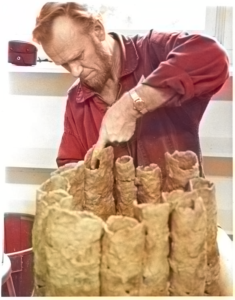Victor Brosz

(1925-1999) born in Portland, Oregon and lived and worked in Calgary, Alberta, Canada
Time Remembered, 1975
stoneware, salt glaze, 23 x 14 x 10 inches, 93.39.235



Left: Brosz, “Pinches small slabs of clay into a circular sculpture form to become human-like figures. Oxides are pressed into the clay for surface subtleties.” 1975 ICS catalogue. Center: Brosz “Forms a figure from a solid mass of extruded clay.” 1975 ICS catalogue Right: Now Where? 1975, unglazed stoneware, 30.25 x 13 inches, 93.39.232 and 233
Although born in Portland Oregon, Victor Brosz spent the majority of his life in Alberta, Canada. Brosz worked in the Alberta School System for 22 years, first as a teacher, then as a school administrator and art supervisor. He then decided to attend college as a mature student and earned a Bachelor’s of Education from the University of Alberta in 1960, and a Master’s of Education from the University of British Columbia in 1966. In addition, he took classes at the Banff School of Fine Arts and at the University of Washington. He married Mary Amanda Gwen Morrison and had four children: Tyman, David, Roberta, and Yvonne.
Brosz joined the University of Calgary’s Department of Art in 1966, and served as Department Head from 1974-1979. Throughout his career Brosz was very active in a number of professional organizations, most notably the Alberta Potters’ Association, which he helped to start and served as the first president from 1970-1972. He taught numerous workshops, wrote articles for the magazine Ceramics Monthly, as well as exhibited his work internationally. Though his primary interest was in ceramics, he was also passionate about sketching, watercolor painting, mixed media art, amateur theater, and Scottish Country dance.
In the spring of 1971, under the auspices of the International Academy of Ceramics, the Tennessee Arts Commission pledged its support for the promotion and establishment of the U.S. International Ceramic Symposiums. The Symposium’s mission to help develop a worldwide network of support for ceramic art was achieved by bringing together top ceramic artists from around the world for a month-long sharing of ideas and creation of innovative ceramics.
Brosz represented Canada at the Second U.S. International Ceramic Symposium, which consisted of twelve artists from seven different countries, and was hosted in the summer of 1975 at the Arrowmont School of Crafts in Gatlinburg, TN. He devoted much of his focus at the Symposium to working with large pieces of porous stoneware clay to create free-form simplifications of the human body, as well as forms that strongly embrace geometry. Ceramics Monthly reports these figure-like forms as depictions of the “visual postures of mankind in communication.’’[1] These pieces were fired in a stacked kiln, in which temperatures of at least 2000 degrees Fahrenheit were reached by filling the kiln with alternating layers of sawdust and charcoal.
After retiring from the University of Calgary’s Department of Art in 1986, Brosz moved to Okanagan Valley with his new partner Leonard Driscoll, where they operated a popular Bed & Breakfast from 1991 to 1999. Described as “pillars of Okanagan Valley’s gay and lesbian community,”[2] the two were active figures in the Valley until 1999, when Brosz was killed by his partner Driscoll in what police classified as a case of domestic violence. A memorial scholarship was established at the University of Calgary for both Victor and his son Tyman, who had passed away at an early age.
Victor Brosz’s work can be found in various collections across Canada, including at the Alberta Foundation for the Arts, the Nickle Arts museum at the University of Calgary and the Mills College Art Museum in Oakland, California.
[1] Darrow, James. Symposium at Arrowmont. Ceramics Monthly. March 1976.
[2] Perceptions Magazine. September 15, 1999. Page 26.
Written by Aiden Layer, TN Arts Intern

